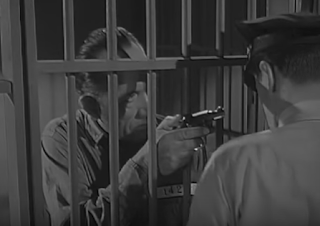This is the film noir Breakout, directed by Peter Gunn from 1958. It starts with a long shot of two males walking through a room which looks like a prison. The whole film is in black and white, hence film ‘noir’. There is music playing which helps to set the scene and emphasise the fact it is set in a prison. You can also hear the diegetic sound of footsteps. The shadows on the walls emphasise how there is going to be trouble in the following scenes.

There is a close up of one each of the men followed by a shot reverse shot to the other man in the cell. The screenshot shown here shows a high angle of the second man, revealing the opposite to the shot of the other man, with a low angle. This represents the status differences between the two. However, the music creates tension which emphasises how these status roles may change throughout the film.

The music then changes into a minor key which creates a dramatic, tense feeling for the audience. There is a slight high angle here which shows the man with the gun has the power in this clip. Further demonstrating this is that the other man’s face is covered, with his back to the camera. The use of cross cutting onto this scene tells the audience the man is up to something which is revealed later on.
Here is a clip of the man breaking out opening up the cell, just after he has hurt two of the officers. The way the man’s face is cut out of the picture resembles how this action is not going to end well for him. The focus is on the keys in the lock, so that the audience can watch him succeed in his action of breaking out of prison. We can hear the diegetic sound of the keys in the lock which matches what we see, giving consistency. He is placed in the middle of the screen which suggests he has the most power, possibly because he has a gun.
This is similar to the first scene of the film, just at a different angle and position. This is suggesting that there has been change since the film started. The slight low angle and off centre shot of the officer makes him look very small, showing that he does not have control of the situation. The shadows give the film an unnerving feeling, but the way they are placed over the officer could also foreshadow death.
This close up shows the panic on the officer’s face as he realises the man has escaped. The clip is quite burry which shows his confusion and the clip soon cuts away from his face, making the audience have a ‘double-take’, connoting that is what the officer did when he realised the prisoner was not there. There is a low angle on the character, showing he could be feeling aggressive and angry at the man. The music becomes louder at this point, with an alarm sounding in the background. Both emphasising the panic and confusion.
This transitions to a high angle of a very dark, shadowy staircase and we see a man walk out of a door below, this makes him look very little and vulnerable. The music is very gentle here, proposing this is a calmer environment than the previous scene. The camera follows the man and he looks directly into the camera, giving the feeling of being watched but he knows that he is under surveillance, making the audience question why. The music becomes quite jolly, as the camera keeps on this man. This gives a contrast/juxtaposition between this character and the man who is trying to escape as well as between the scenes.
This scene is the first time we hear any form of dialogue, proposing that these characters know each other and like each other. The quality of the sound is not very good, which shows how technology has developed from the time the film was produced. As the man walks in the door, there is a shot reverse shot which shows a man in a wheelchair with a mask on his face, we cannot see the man speaking which creates confusion
among the audience. The man is positioned in the middle of the screen which reveals his whole body as well as emphasises that he is in a wheelchair. It makes the audience want to continue to watch the film so that they can find out what is wrong with the man, as they feel sympathy for him as it looks like he has been in some kind of accident or has a medical condition. After this scene, there is a fade out which shows it is the end of this scene.







No comments:
Post a Comment